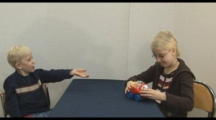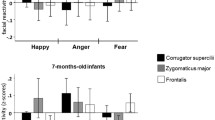Abstract
We studied the relation between direction of gaze and smiling in 15 typically developing infants and 15 infants with Down syndrome. All of them were videotaped during face-to-face interaction with their mothers at home, and while having access to their familiar toys. Results showed that mothers in the two groups behaved in a similar way; that Down syndrome infants looked at their mother's face for longer than typically developing children; and that the relationship between looking and smiling was similar in the two cases and reflected as an increase in the time the infant looked at its mother's face and a decrease in the time the infant looked at toys. It was deduced that Down syndrome infants are capable of distinguishing the differential significance of faces and toys, so that, in the same way as typically developing infants, they direct their affective behavior fundamentally towards the social element, which leads us to consider the affiliative function implied by this expression.
Similar content being viewed by others
References
Berger, J. & Cunningham, C.C. (1981). The development of eye contact between mothers and normal and Down's syndrome infants. Developmental Psychology, 17, 678–689.
Braungart-Rieker, J.B.; Garwood, M.; Powers, B.P. & Notaro, P.C. (1998). Infant affect and affect regulation during the still-face paradigm with mothers and fathers: the role of infant characteristics and parental sensitivity. Developmental Psychology, 34, 1428–1437.
Brazelton, T.B.; Koslowski, B. & Main, M. (1974). The origins of reciprocity: The early motherinfant interation. In M. Lewis & L.A. Rosenblum (Eds.), The effect of the infant on its caregiver (pp. 49–76). New York: Wiley.
Campos, J.; Barrett, K.C.; Lamb, M.E.; Godsmith, H.H. & Stenberg, C. (1983). Socioemotional development. In M. Haith & J. Campos (Eds.), Infancy and developmental psychobiology. New York: Wiley.
Carr, V. (1970). Mental and motor development of young Mongol children. Journal of Mental Deficiency Research, 14, 205–220.
Carvajal, F. & Iglesias, J. (1997). Mother and infant smiling exchanges during face-to-face interaction in infants with and without Down syndrome. Developmental Psychobiology, 31, 277–286.
Crown, C.L.; Feldstein, S.; Jasnow, M.D.; Beebe, B. & Jaffe, J. (1992). Gaze behavior of Down's syndrome and nondelayed infants in interactions with their mothers. Acta Paedopsychiatrica, 55, 51–55.
Dimberg, U. (1982). Facial reactions to facial expressions. Psychophysiology, 19, 643–647.
Dodwell, P.C., Humphrey, G.K. & Muir, D.W. (1987). Shape and pattern perception. In L.B. Cohen & P. Salapatek (Eds.), Handbook of infant perception (Vol.2, pp. 1–77). San Diego: Academic Press.
Ekman, P. & Friesen, W.V. (1978). Facial expressions of emotion. Annual Review of Psychology, 30, 527–554.
Ellsworth, C.P., Muir, D.W. & Hains, S.M.J. (1993). Social competence and person-object differentiation: an analysis of the still-face effect. Developmental Psychology, 29, 63–73.
Exline, R.V. (1982). Gaze behavior in infants and children: a tool for the study of emotions? In C.E. Izard (ed.), Measuring emotions in infants and children (pp. 164–177). Cambridge: Cambridge Univeresity Press.
Exline, R.V. & Yellin, A. (1969). Eye contact as a sign between man and monkey. Proceedings of the 19th International Congress of Psychology. London: Methuen.
Field, T. (1981). Infant gaze aversion and heart rate during face-to-face. Infant behavior and development, 4, 307–315.
Fogel, A.; Young, J. & McEwen, I. (1992). Efect of postural position and reaching on gaze during mother-infant face-to-face interaction. Infant Behavior and Development, 15, 231–244.
Fox, N.A. & Davidson, R.J. (Eds.) (1984). The psychology of affective development. Hillsdale, NJ: LEA.
Gunn, P.; Berry, P. & Andrews, R.J. (1982). Looking behavior of Down syndrome infants. American Journal of Mental Deficiency, 87, 347–350.
Gusella, J.; Muir, D. & Tronick, E. (1988). The effect of manipulating maternal behavior during an interaction on 3-and 6-month-old's affect and attention. Child Development,59, 1111–1124.
Hains, S.M.J. & Muir, D.W. (1996). Infant sensitivity to adult eye direction. Child Development, 67, 1940–1951.
Harris, S.; Kasari, C. & Sigman, M.D. (1996). Joint attention and language gains in children with Down syndrome. American Journal on Mental Retardation, 100, 608–619.
Hinde, R.A. & Rowell, T.E. (1962). Comunication by posture and facial expressions in the rhesus monkey (Maccaca mulatta). Proceedings of the Zoological Society of London, 138, 1–21.
Izard, C.E. (1977): Human emotion. New York: Plenum Press.
Izard, C.E. & Malatesta, C.Z. (1987). Perspectives on emotional development I: differential emotions theory of early emotional development. In J.D. Osofsky (Ed.), Handbook of infant development (2nd edition) (pp. 494–554). New York: Wiley.
Kasari, C.; Freeman, S.; Mundy, P. & Sigman, M.D. (1995). Attention regulation by children with Down syndrome: coordinated joint attention and social referencing looks. American Journal on Mental Retardation, 100, 128–136.
Kasari, C.; Mundy, P.; Yirmiya, N. & Sigman, M. (1990). Affect and attention in children with Down syndrome. American Journal on Mental Retardation,95, 55–67.
Landry, S.H. & Chapieski, M.L. (1989). Joint attention and infant toy exploration: effects of Down syndrome and prematurity. Child Development, 60, 103–118.
Landry, S.H. & Chapieski, M.L. (1990). Joint attention of six-month-old Down syndrome and preterm infants: I. Attention to toys and mother. American Journal on Mental Retardation, 94, 488–498.
Legerstee, M.; Anderson, D. & Schaffer, A. (1998). Five-and eight-month-old infants recognize their faces and voices as familiar and social stimuli. Child Development, 69, 37–50.
Legerstee, M. & Bowman, T.G. (1989). The development of responses to people and a toy in infants with Down syndrome. Infant Behavior and Development, 12, 465–477.
Legerstee, M.; Corter, C. & Kienapple, K. (1990). Hand, arm and facial actions of young infants to a social and nonsocial stimulus. Child Development, 61, 774–784.
Legerstee, M., Pomerleau, A., Malcuir, G. & Feider, H. (1987). The development of infants' responses to people and a doll: implications for research in communication. Infant Behavior and Development, 10, 81–95.
Lynch, M.P. & Eilers, R.E. (1991). Perspectives on early language from typical development and Down syndrome. In N.W. Bray (Ed.), International review of research on mental retardation. New York: Academic Press.
Miller, J.F. (1988). The developmental asynchrony of language development in children with Down syndrome. In L. Nadel (Ed.), The psychobiology of Down syndrome (pp. 167– 198). Cambridge: MIT Press.
Mundy, P.; Sigman, M.; Kasari, C. & Yirmiya, N. (1988). Nonverbal communication skills in Down syndrome children Child Development, 59, 235–249.
Ohr, P.S. & Fagen, J.W. (1994). Contingency learning in 9-month old infants with Down syndrome. American Journal on Mental Retardation, 99, 74–84.
Quera, V. (1987). ASR Versión 1.0. Analizador secuencial de retardos.(ASR Version 1.0. Lag sequential analyzer). Barcelona: Departamento de Metodolog´ýa de las Ciencias del Comportamiento. Universidad de Barcelona.
Quera, V. & Estany, E. (1984). ANSEC: A BASIC package for lag sequential analysis of observational data. Behavior Research Methods. Instruments, & Computers, 16, 303–306.
Rutter, D.R. (1984). Looking and seeing. Chichesteer: Willey.
Sackett, G.P. (1979). The lag sequential analysis of contingency and cyclicity in behavioral interaction research. In J.D. Osofsky (Ed.), Handbook of infant development (pp. 623– 649). New York: Wiley.
Sackett, G.P.; Holm, R.; Crowley, C. & Henkins, A. (1979). A FORTRAN program for lag sequential analysis of contingency and cyclicity in behavioral interacion data. Behavior Research Methods & Instrumentation, 11, 366–378.
Stack, D.M. & Muir, D.W. (1992). Adult tactile stimulation during face-to-face interactions modulates 5-month-olds' affect and attention. Child Development,63, 1509–1525.
Stern, D.N. (1974). Mother and infant at play: The dyadic interaction involving facial, vocal and gaze behaviors. In M. Lewis & L.A. Rosenblum (Eds), The effect of the infant on its caregiver (pp. 187–213). New York: Wiley.
Stifter, C.A. & Moyer, D. (1991). The regulation of positive affect: gaze aversion activity during mother-infant interaction. Infant Behavior and Development, 14, 111–123.
Toda, S. & Fogel, A. (1993). Infant response to the still face situation at 3 and 6 months. Developmental Psychology, 29, 532–538.
VonGrünau, M. & Anston, C. (1995). The detection of gaze direction: a stare-in-the-crowd effect. Perception, 24, 1297–1313.
Weinberg, M.K. & Tronick, E.Z. (1994). Beyond the face: An empirical study of infant affective configurations of facial, vocal, gestural, and regulatory behaviors. Child Development, 65, 1503–1515.
Author information
Authors and Affiliations
Rights and permissions
About this article
Cite this article
Carvajal, F., Iglesias, J. Looking Behavior and Smiling in Down Syndrome Infants. Journal of Nonverbal Behavior 24, 225–236 (2000). https://doi.org/10.1023/A:1006693121491
Issue Date:
DOI: https://doi.org/10.1023/A:1006693121491




